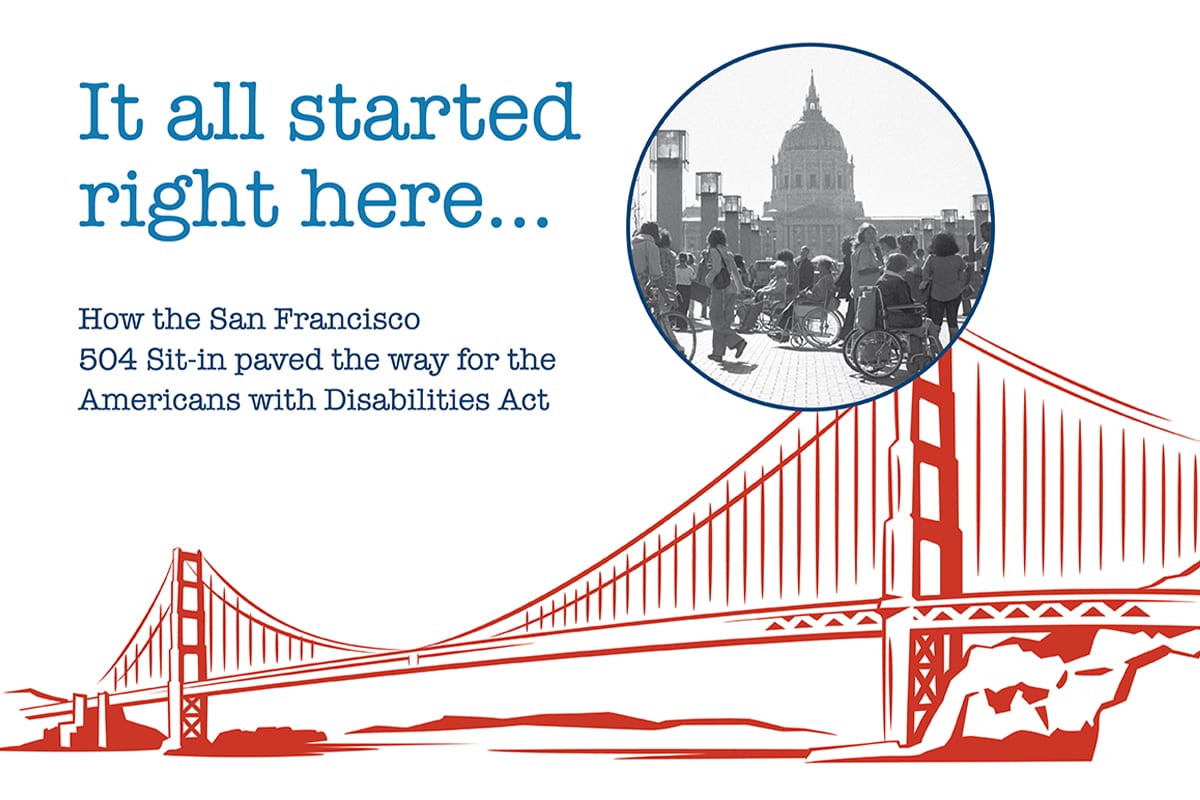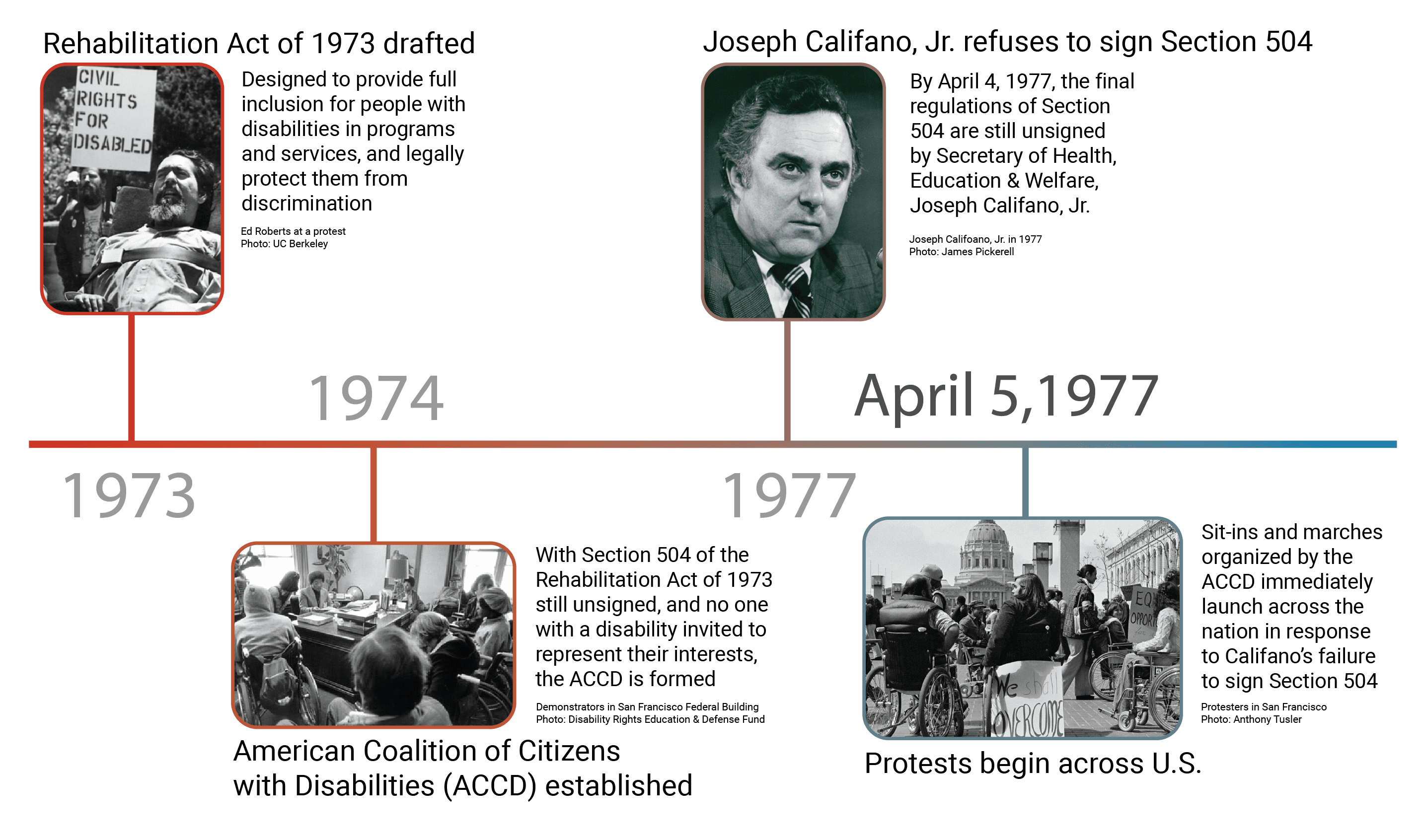
The ADA Turns 28
Written by Abigail Guerdat, Communications & Grants Associate at Easterseals Northern California
On July 26, the Americans with Disabilities Act (ADA) will celebrate its 28th year as a law. This vital legislation was the culmination of decades of work, much of which took place in the San Francisco Bay Area by trailblazers of the disability rights movement. This month, we honor the champions who fought for their rights and started a social movement for equality.

504 Sit-in: The Longest in U.S. History
On April 5, 1977, hundreds of people with disabilities and advocates alike occupied federal buildings throughout the U.S. in an attempt to fully establish the regulations of Section 504 of the Rehabilitation Act of 1973—the most vital disability rights legislation in the U.S. until the enactment of the Americans with Disabilities Act in 1990.
However, by 1977 the regulations within Section 504 of the Rehabilitation Act of 1973 had still not been published. After back-and-forth between various federal offices and Congress, the disability community grew impatient—and rightly so. Not a single person with a disability was invited to represent the interests of the community during this process, so the American Coalition of Citizens with Disabilities (ACCD) was established.
By April 4, 1977 the final regulations were still unsigned by the Secretary of Health, Education and Welfare, Joseph Califano; on April 5, 1977, sit-ins and marches organized by the ACCD launched across the nation. People gathered in Washington, D.C., Atlanta, Los Angeles, Chicago, New York City, and more. Unfortunately, these sit-ins ended after just 28 hours, but in San Francisco, the 150-person sit-in, led by disability rights activists Judith Heumann, Kitty Cone, and Mary Jane Owen, continued for an entire month in the Federal Office Building. To date, San Francisco’s sit-in is still the longest sit-in of a federal building in U.S. history.
Outpouring of Support
The protesters had an outpouring of support from an abundance of progressive citizens and social activists within the Bay Area. City staff provided them with air mattresses, showers, and new pay phones, and the Black Panther Party provided daily meals to the occupiers. Even San Francisco’s Mayor, George Moscone, supported the occupation, along with numerous senators.
During the sit-in, the protesters discovered that Califano was planning to make nefarious changes to the regulations within Section 504, including the elimination of mandatory ramps in public spaces like hospitals and schools. This drew the attention of Ed Roberts—the head of the California State Department of Rehabilitation, founder of the nation’s first Disabled Students Program, and former Easterseals client; he rebuked this “separate but equal” approach, and stated, “Integration is the key word: people with disabilities have to come back into our society”.
Support Leads to Social Change
On April 28, 1977, the regulations were finally signed by Califano. It was the activists’ efforts, support from the community, and the month of televised and written news coverage that helped secure the implementation of Section 504. This victory marked enormous growth for disability rights and brought people with varying disabilities together to get the recognition they deserved. It was one of the most impactful pieces of legislation for people with disabilities at that point, ensuring protections until the ADA was signed into law in 1990.
Now that you know how the Americans with Disabilities Act came to be, aren’t you proud to support Easterseals Northern California? If the 504 Sit-in taught us anything, it’s that societal support leads to social change. This year, celebrate the progress that led to this important law and honor the women and men who championed for rights and inclusion for people with disabilities and special needs.
Show how you celebrate! On July 26, create a virtual sign (a photo, video, or personal story) that shows your pride and support and use #VirtualDisabilityParade to show your pride.
More Stories
How to Make Your Holiday Celebrations Inclusive for Everyone
Holidays bring opportunities to spend time with loved ones. Follow these tips to learn how you can make your holiday celebrations inclusive for everyone!
Giving Tuesday: Help Families Soar
Learn about qualifying for Social Security benefits, available to adults who cannot work because of Autism Spectrum Disorder and for parents of children with ASD.

Connect with Us